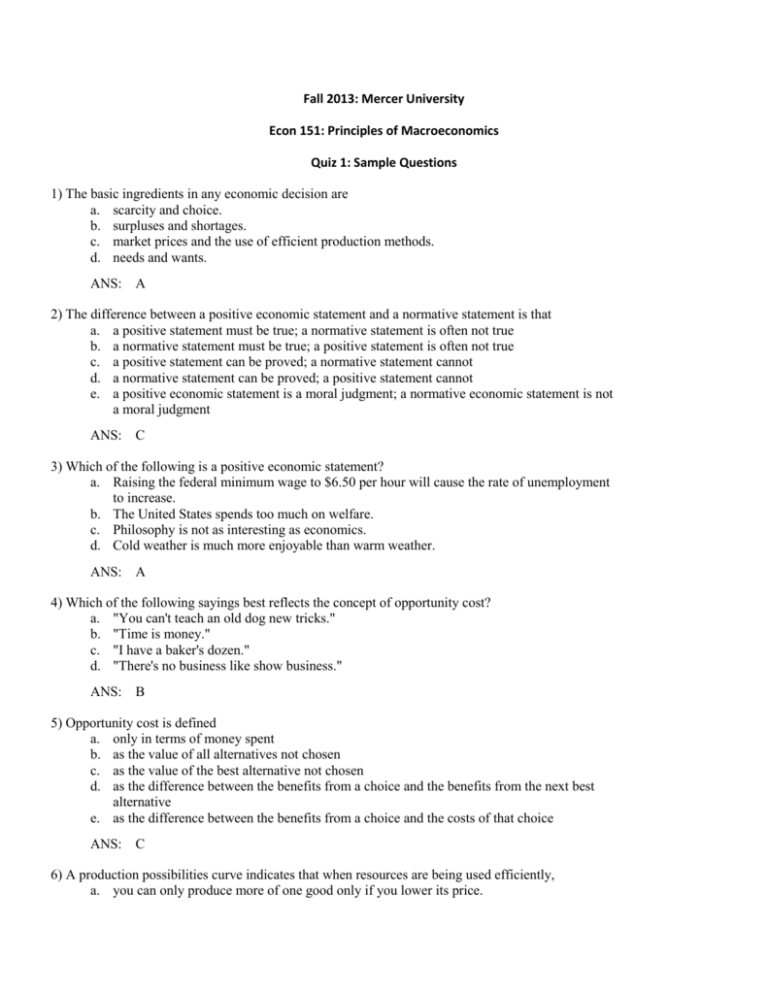Sample - Mercer University
advertisement

Fall 2013: Mercer University Econ 151: Principles of Macroeconomics Quiz 1: Sample Questions 1) The basic ingredients in any economic decision are a. scarcity and choice. b. surpluses and shortages. c. market prices and the use of efficient production methods. d. needs and wants. ANS: A 2) The difference between a positive economic statement and a normative statement is that a. a positive statement must be true; a normative statement is often not true b. a normative statement must be true; a positive statement is often not true c. a positive statement can be proved; a normative statement cannot d. a normative statement can be proved; a positive statement cannot e. a positive economic statement is a moral judgment; a normative economic statement is not a moral judgment ANS: C 3) Which of the following is a positive economic statement? a. Raising the federal minimum wage to $6.50 per hour will cause the rate of unemployment to increase. b. The United States spends too much on welfare. c. Philosophy is not as interesting as economics. d. Cold weather is much more enjoyable than warm weather. ANS: A 4) Which of the following sayings best reflects the concept of opportunity cost? a. "You can't teach an old dog new tricks." b. "Time is money." c. "I have a baker's dozen." d. "There's no business like show business." ANS: B 5) Opportunity cost is defined a. only in terms of money spent b. as the value of all alternatives not chosen c. as the value of the best alternative not chosen d. as the difference between the benefits from a choice and the benefits from the next best alternative e. as the difference between the benefits from a choice and the costs of that choice ANS: C 6) A production possibilities curve indicates that when resources are being used efficiently, a. you can only produce more of one good only if you lower its price. b. you can only produce more of one good only if you produce more of another good. c. you can only produce more of one good only if you produce less of another good. d. it is impossible to expand the total output of goods over time. ANS: C Figure 2-1 7) In Figure 2-1, point A is a. unattainable. b. inefficient. c. efficient. d. preferable to point B. ANS: B 8) A form of economic organization that relies primarily on private ownership of productive assets, freedom of exchange, and market prices to allocate goods and resources is often called a. national socialism. b. the welfare state. c. a corporate economy. d. capitalism. ANS: D 9) The height of the demand curve for a product indicates the a. minimum price consumers are willing to pay for an additional unit of it. b. minimum quantity consumers are willing to purchase at the current price. c. maximum price consumers are willing to pay for an additional unit of it. d. minimum price required to induce suppliers to produce an additional unit of it. ANS: C 10) If consumer tastes are changing more in favor of the consumption of a particular good the a. market demand curve will shift to the left. b. consumer will move up a given demand curve, decreasing the quantity demanded. c. consumer would move down a given demand curve, decreasing the quantity demanded. d. consumer would move down a given demand curve, increasing the quantity demanded. e. market demand curve would shift to the right. ANS: E







